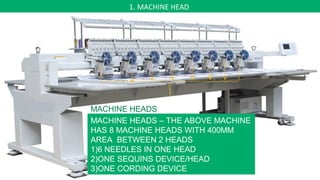Emb basic
- 1. EMBROIDERY MACHINE – BASICS
- 2. Also called digital embroidery, this pastime is the newest and fastest way to decorate fabric with thread. A computerized embroidery machine holds a small piece of the fabric taut and moves the needle in accordance with a programmed pattern. Home embroidery machines and commercial embroidery machines, both requiring the use of a computer. Home machines are built for small projects; they usually have one needle, meaning they can do only one garment at a time. About the same size as a traditional sewing machine, they don’t take up much space. Commercial machines, on the other hand, are built for production work and have several needles. These beasts can take up entire rooms and cost several thousand dollars. EMBROIDERY MACHINES
- 3. MACHINE HEADS – THE ABOVE MACHINE HAS 8 MACHINE HEADS WITH 400MM AREA BETWEEN 2 HEADS 1)6 NEEDLES IN ONE HEAD 2)ONE SEQUINS DEVICE/HEAD 3)ONE CORDING DEVICE MACHINE HEADS 1. MACHINE HEAD
- 4. A multi-needle machine may consist of multiple sewing heads, each of which can sew the same design onto a separate garment concurrently. Such a machine might have 20 or more heads, each consisting of 15 or more needles. A head is usually capable of producing many special fabric effects, including satin stitch embroidery, chain stitch embroidery,sequins, appliqué, and cutwork. EMBROIDERY MACHINE HEAD 15 NEEDLES IN ONE HEAD 1. MACHINE HEAD
- 6. AN LED CONTROL PANEL 2. USER CONTROL PANEL
- 7. 2. USER CONTROL PANEL
- 8. LED CONTROL PANEL 1)LETS USER SET FRAME AND DESIGN 2)LETS USER SELECT AND LOAD A DESIGN 3)LETS USER INPUT COLOR CHANGE SYSTEM 4)LETS USER DECIDE OTHER IMPORTANT MACHINE PARAMETERS 2. USER CONTROL PANEL
- 9. 1) ALL THE THREADS ARE PLACED ON THIS STAND 2) THREADS ARE INTERWINED WITH THE PARTS OF THIS STAND TO ENSURE SINGLE CONTINOUS SMOOTH THREADS ARE SENT TO NEEDLES FOR EMBROIDERY THREAD FEEDING STAND 3. THREAD FEEDING STAND
- 10. 1) STABILISES THE FABRIC AND PLACES IT ON MACHINE 2) To avoid the movement of the design whilst being stitched as described above’ 3) Stabilizers or interfacing are added beneath or on top of the fabric, or both In a Frame. A RECTANGULAR FRAME 4. FRAMES
- 11. 1) A RECTANGULAR FRAME – FASTENS A FABRIC ON MACHINE WHICH HAS CONTINOUS REPETITIVE DESIGN 2) THESE FABRICS ARE GENERALLY CALLED ALL OVER FABRICS. CONTINOUS ALL OVER FRAME 1) THE SAME RECTANGULAR FRAME IS FITTED WITH DIVIDERS , THIS HELPS IN EMBROIDERING FABRIC WHOSE DIMENSIONS ARE LESS THAN FRAME DIMENSIONS, FRAME WITH DIVIDERS 4. FRAMES
- 12. 1) A HOOP – RING FRAME IS USED WHEN THE DIMENSION OF FABRIC WHICH NEEDS TO EMBROIDER IS SUCH THAT IT CAN FASTENS PROPERLY ONLY IN CYLINDRICAL MANNER HOOP –RING FRAME 1) A SPHERICAL ADJUSTABLE RING WHICH CAN CLAMP A FABRIC WITH HOOKS, SUITABLE FOR EMBROIDERING ON CAPS SPHERICAL FRAME WITH CLAMPS 4. FRAMES
- 13. SPECIAL DEVICES 1) VARIOUS SPECIAL DEVICES COME INSTALLED OR CAN BE LATER ATTACHED TO THE HEADS OF EMBROIDERY MACHINE 2) SEQUINS, CORDING AND LASER HEADS HELPS US EMBELLSH A FABRIC WITH DIFFERENT MATERIAL THEN THREADS 5. DEVICES
- 14. 5. DEVICES
- 15. 5. DEVICES
- 16. 5. DEVICES















